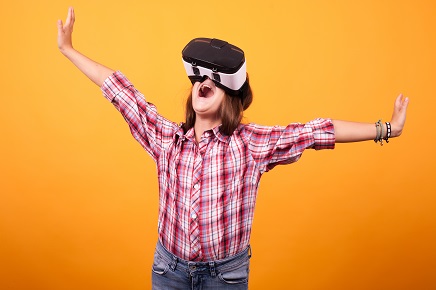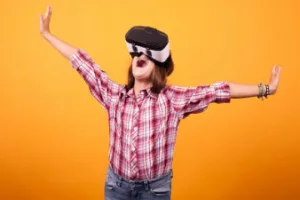I was on my way to Southern Utah to compete in the national senior games when I received an email from Bob Raikes asking my ‘educator’s’ opinion on this recent announcement:
“ABI Research said that over the next five years, steady growth will mean shipments of 50.1 million VR headsets by 2026, a CAGR of 42% and will lead to $56 billion in VR market revenues by the same time. Stand-alone headsets will rise from 44% this year to nearly 80% of the market. Education mixes consumer and enterprise and is the second largest segment by shipments and first by revenue; 11 million HMD shipments are expected in education in 2026, with $20 billion in total market revenue”.

Since I was indisposed, Bob published his commentary without any additive thinking on my part. He concluded:
“Hmm… this is an aggressive forecast, I think. On the other hand, products are getting better and better and companies are still investing. Even if it only turns out to be half this big, it’s a significant opportunity”.
After securing fourth place nationally in our competitive volleyball skirmishes, I put forth some mental effort to parse through some of the observational and quantifiable data on this matter. In the end, Bob’s take on this is perhaps more positive than my own. Will VR experience explosive growth in education markets, specifically the K-12  setting? I think not, with only the exception of a cut out for medical education in higher education and hospitals. Why am I so pessimistic, you ask? Here’s why. I believe there are significant legacy obstacles, more recent Rona-driven hurdles, and even some fresh-cut developments that will likely slow any predicted burst of adoption, blunting enthusiasm for this remarkably immersive technology in the K-12 sector. These data points are highlighted below.
setting? I think not, with only the exception of a cut out for medical education in higher education and hospitals. Why am I so pessimistic, you ask? Here’s why. I believe there are significant legacy obstacles, more recent Rona-driven hurdles, and even some fresh-cut developments that will likely slow any predicted burst of adoption, blunting enthusiasm for this remarkably immersive technology in the K-12 sector. These data points are highlighted below.
Legacy obstacles
- The lack of rich curricular content for VR in education remains profound. Given the typical “chicken-or-the-egg” argument, it’s this simple for VR in schools: the content egg must come first. And it’s not just the quantity and coverage of content, it’s about having quality content that goes richly beyond the “field-trip” rut that most content developers have pursued to date. Until then, VR in schools will remain in the supplemental, and not the core curriculum bucket.
- The lack of ecosystem maturity will continue to be a barrier for VR expansion in schools. The needs are many: easy-to-use digital software management tools, inexpensive storage systems; charging systems; facile maintenance and parts replacement issues (think components, batteries, and the like); trade-in / trade-up programs and end of life disposal systems. It is impossible to see the explosive growth of VR in schools without maturity in these ancillary areas.
- The lack of transformative use case(s) continues to stagnate VR in schools. Even when Google provided all their immersive resource and content for free to schools, VR never held a real seat at the table. It is all about the schools placing VR in the supplemental and not the core curriculum bucket. I still haven’t seen a game-changing use case in K-12, although we are clearly making some headway in medical education.
Rona-driven hurdles
- Thanks to the Rona, VR still carries an undersized presence at national ed-tech conferences. During the last three years, VR evidenced a shift from 66 to 24 to 35 sessions offered at the largest U.S. conference this last summer, ISTE Live 2021. I will be tracking the trajectory of VR at two upcoming educational conferences to see if this changes, but for now, VR has not continued an upward trajectory in K-12.
- Fear has also proved to be a significant restraining force. The Rona really put the kibosh on individually worn headgear in school settings. Even though the Rona is an airborne disease, educators world-wide have been reticent to bring it back into the classroom. All shared resources (classroom resources that don’t belong to individual students, but are shared with students throughout the school day—like VR has been) are slow to return to daily use. Teachers have told me personally that they are afraid to use VR headgear, and that the repeated between-use sanitization that is now required is quite onerous.
- Overall, the use of VR in schools has taken a direct hit by the pandemic and an obvious competing need to chase distance learning resources. This loss of momentum means a lot. Translation: VRs intake in K-12 is likely to be slower and less than originally hoped for. I don’t like it, but that’s what seems to be happening.
Fresh-cut impediments
- Google has stepped away, in part, from the VR in education arena. They’ve folded the somewhat popular Google expeditions into Google Arts and Culture, and teachers are complaining about both the quality and inaccessibility of resources under the new regime.
- Students are largely back in physical attendance at schools, but VR is still not taking off. I just don’t see and hear the buzz anymore. Competing priorities seem to shout, while VR seems to whisper.
My call, for all the reasons above, is that we will see slower growth and sales than this ABI Research forecast tempts us with, at least in K-12 communities. Yet lots can happen in five years, which is an eternity. Many of these things can change, but for now, lower your expectations—Len Scrogan
Analyst Comment
I wouldn’t argue with any of Len’s point. I think he’s right, VR has a long way to go in education. (BR)

